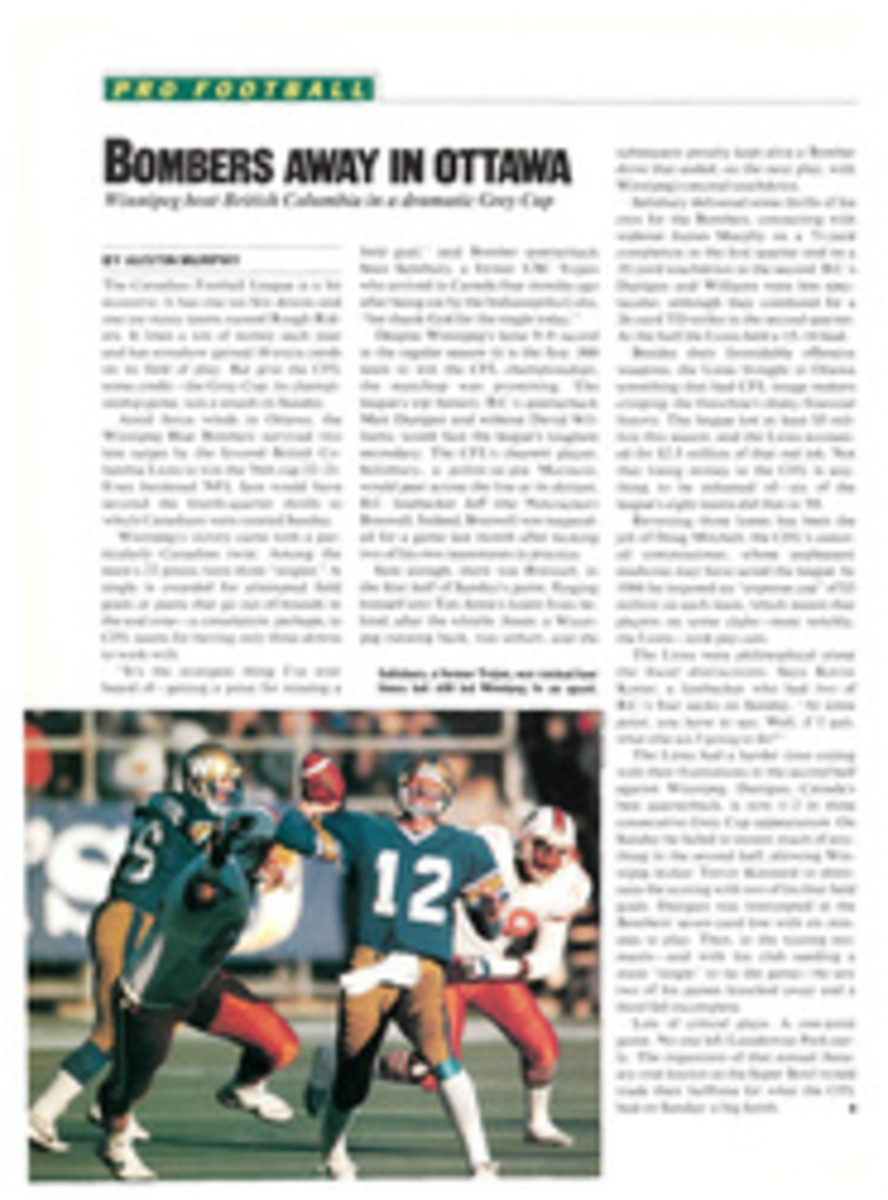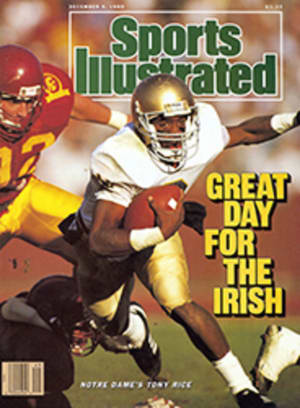
TIMM-BERRR! A LOGGER NABS A FOOTBALL FALLING AT 100 MPH
I own a Denver Bronco trophy buckle, along with the bragging rights to a Bronco record that has stood for five years and may be an NFL mark as well. The inscription on the silver belt buckle reads 90 P.S.I., sterling evidence of what may be the most insane feat in sport (or on the perimeter thereof): catching a football as it plummets to earth at some 100 mph.
As a logger, or more specifically, a timber faller (a woodsman who fells trees for commercial logging), I had spent most of the year with my hands curled around a 40-pound chain saw. I had been packing that saw for three months on the steep, snowy Rockies of Montana in 1983 when I decided to hang up my hard hat and head to Denver for a family Christmas. Most of my eight brothers and sisters planned to be there, including my brother Bill, who at the time worked as the equipment manager for the Broncos. My wife and I knew that Bill wouldn't be on the road with the team, because as we drove through Wyoming we listened on the radio to the AFC wild-card game in Seattle. It put a damper on that Christmas Eve ride to hear Denver going down 31-7.
By the time we arrived at my mother's house, Bill had returned from Seattle and was sitting in the living room. He was his usual taciturn self, shrugging off defeat and enjoying all his wee nieces and nephews and their sugarplum anticipations.
We tried to coax bits of locker room gossip from Bill. It's hard to think of his dealings with the Broncos as being boring or humdrum, but he rarely had much to say about what his days were like. Finally, on Christmas night, he started to tell us about a "football cannon" that the Broncos were using for punt and kickoff return practice.
The machine used compressed air to shoot footballs. Forty pounds per square inch (p.s.i.) would launch the ball in a fair imitation of an NFL-caliber kick. But boys will be boys, and somebody got the idea of letting the compressor run up to 90 p.s.i. and pointing the business end of the machine straight up to see what would happen. Bill said the ball nearly disappeared from view before it fell back to earth. Then somebody decided to try to catch the ball when it came screaming down. Bill said it was one of the funniest things he ever saw. Guys who made zillions of dollars catching footballs were unable to handle this leather meteorite. He said it was a challenge just to catch the ball on the bounce. In fact, when Bronco kicker Rich Karlis misjudged one ball, it grazed his helmet, hit the ground and bounced onto the roof of a nearby warehouse. Bill said that the ball had to be doing at least 300 mph.
"Baloney, Bill," I said. I told him (we're all amateur physicists at heart) that every falling object has a terminal velocity, and by quick, and perhaps dubious, mental calculations I reckoned that the velocity for a football was closer to 100 mph. Then, before I had to start backing up my theory with more precise math, I said as calmly as possible, "I could catch it." He laughed derisively.
Now was the time for me to apply some amateur psychology. "Those big prima donnas are psyching themselves out because they've never seen a football coming at them that fast, even with Elway throwing it at them," I said. "I have the advantage of not knowing the difference. I could do it if I had five chances."
"Tom, I would bet you any amount of money it can't be done. You wouldn't believe it. No, you can't do it," Bill said. He was both a little steamed and a little amused by my bragging.
"I won't take your money," I said, "but I'd sure like to have a go at it. Five tries?"
"You're on. Come on out tomorrow."
The next day the temperature was about 25°, and a few inches of new snow covered the Bronco practice field. Bill set the machine up and got the compressor going. When he shot the first ball into the Denver smog, it set me back some. I have cut down thousands of trees. After a felled tree hits the ground and I have finished bucking the sawlogs, I know within inches how tall the tree was. I have climbed 300-foot-tall radio towers to replace burned-out beacons. In short, I can judge heights that have some correlation to human activity. But that ball disappearing into the dirty air and ripping back down to the ground was unlike anything I could relate to. I guessed that the apex of its flight was around 350 feet.
Bill shot a few more balls up so I could get into the general area where they were rocketing down. I could see them shifting through different wind strata as they returned to earth. Then one came near enough for me to try to catch it. It hurt my left thumb. But I could see how a few more tries would teach me enough to get the job done. The second ball that fell toward me tore the fingernail off my left index finger and bent the whole finger up pretty badly. Bill saw the blood and shut off the compressor. "This is crazy. That's enough," he said.
"It looks worse than it is," I said. "Deal's a deal, Bill. I get three more tries."
While the compressor pumped itself up again, so did I, concentrating on all the strength that I had accumulated in those years of lugging around chain saws. When the next ball came down, it lodged in the cradle formed by my arms and chest. It felt like an 80-pound bale dropped from a hayloft, but I held on to it. It knocked me down, but no one doubted it was a clean catch.
Every once in a while you have to be your own hero: whether it's being the best snow shoveler on the block, or knowing your kids are growing up as polite as can be, or having a sense of yourself as being a playful and crazy enough guy to catch a ball shot out of a cannon.
Steve Antonopulos, the trainer for the Broncos, stuck my hand in ice water for 15 minutes. Cryotherapy he called it. There's a loaded word for you. He manipulated my fingers slightly after taking my hand out of the cold water and said I had better see a doctor. My left thumb and index finger were both broken. Bill was sorry and angry that what had started out to be fun had turned painful. But we talked about all the times we had seen athletes play unaware of their own injuries until later. The human body can take a lot.
I lost a couple of months' work while I wore a cast on my hand. That silver buckle the Broncos gave me cost about $4,000 in lost wages, but I sure like to tell this story.
ILLUSTRATION
TOM CURRY
Tom Harpole, a logger for 12 years, is now an explosives technician and a free-lance writer.

